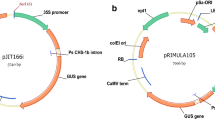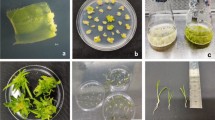Abstract
Plants in the genus Turnera provide a useful system for investigating the molecular genetics of distyly and candidate genes involved in this plant breeding system have been proposed. We develop the first transformation system for the genus, using leaf explant tissue of Turnera joelii transformed using Agrobacterium tumefaciens harbouring the pGreen plasmid. Transgenic plants were successfully regenerated using a two growth-medium method and hygromycin resistance as the selectable marker. This should provide a system for testing the function of candidate genes for distyly. We obtained 19 transgenic plants and explore some of their characteristics. We find at least two instances where chromosomal abnormalities have occurred during the transformation process and observe reduced pollen fertility for seven of the transformants, likely evidence for somaclonal variation. We show that the transgenes inserted into two transgenic plants exhibit expected single gene segregation ratios, but find aberrant ratios for a third transgenic plant. The latter plant exhibits a mutant self-compatible phenotype, where self-compatibility is due to a defect in the incompatibility of its pollen. In crosses, the self-compatible transgenic plant shows marked departures from expected single locus ratios at the S-locus determining distyly, with an almost complete lack of transmission of the dominant S-allele. The plant appears to contain more than one copy of the inserted transgene based upon segregation ratios.






Similar content being viewed by others
References
Alcaraz-Meléndez L, Real-Cosío S, Bashar Y (1994) Domestication of micropropagated plants of the spice damiana (Turnera diffusa). Plant Cell Rep 13:679–682
Alcaraz-Meléndez L, Real-Cosío S, Robert ML (2002) Morphological comparison of damiana (Turnera diffusa, Willd.) regenerated in vitro from leaves cultured in solidified medium and liquid cultures. Sci Hortic 96:293–301
Athanasiou A, Khosravi D, Tamari F, Shore JS (2003) Characterization and localization of short-specific polygalacturonase in distylous Turnera subulata (Turneraceae). Am J Bot 90:675–682
Barrett SCH, Shore JS (2008) New insights on heterostyly: Comparative biology, ecology and genetics. In: Franklin-Tong VE (ed) Self-incompatibility in flowering plants: evolution, diversity and mechanisms. Springer-verlag, Berlin, pp 3–32
Bateson W, Gregory RP (1905) On the inheritance of heterostylism in Primula. Proc R Soc Lond B 76:581–586
Clough SJ, Bent AF (1998) Floral dip: a simplified method for Agrobacterium-mediated transformation of Arabidopsis thaliana. Plant J 16:735–743
Darwin C (1877) The different forms of flowers on plants of the same species. John Murray, London
De Buck S, Jacobs A, Van Montagu M, Depicker A (1999) The DNA sequences of T-DNA junctions suggest that complex T-DNA loci are formed by a recombination process resembling T-DNA integration. Plant J 20:295–304
Deroles SC, Gardner RC (1988) Analysis of the T-DNA structure in a large number of transgenic petunias generated by Arobacterium-mediated transformation. Plant Mol Biol 11:365–377
Díaz-Rondero AJ, Alcaraz-Meléndez L (1987) Callus induction and plantlet regeneration in damiana (Turnera diffusa, Willd.). Plant Cell, Tissue Org Cult 10:39–45
Doyle JJ, Doyle JL (1987) A rapid DNA isolation procedure for small quantities of fresh leaf tissue. Phytochem Bull 19:11–15
Dutta I, Kottackal M, Tumimbang E, Tajima H, Zaid A, Blumwald E (2013) Sonication-assisted efficient Agrobacterium-mediated genetic transformation of the multipurpose woody desert shrub Leptadenia pyrotechnica. Plant Cell Tissue Org Cult 112:289–301
Filipecki M, Malepszy M (2006) Unintended consequences of plant transformation. J Appl Genet 47:277–286
Gilmartin PM, Li J (2010) Delineation of the S-locus in Turnera subulata—homing in on heterostyly. Heredity 105:161–162
Hanahan D (1985) DNA cloning, a practical approach. In: Glover DM (ed) DNA cloning, a practical approach, vol 1. IRL Press, Oxford, pp 109–135
Hellens RP, Edwards EA, Leyland NR, Bean S, Mullineaux PM (2000) pGreen: a versatile and flexible binary Ti vector for Agrobacterium-mediated plant transformation. Plant Mol Biol 42:819–832
Hiei Y, Ohta S, Komari T, Kumashiro T (1994) Efficient transformation of rice (Oryza sativa L.) mediated by Agrobacterium and sequence analysis of the boundaries of the T-DNA. Plant J 6:271–282
Khosravi D, Yang E, Siu K, Shore JS (2004) High level of α-dioxygenase in short styles of distylous Turnera species. Int J Plant Sci 165:995–1006
Kumar SV, Misquitta RW, Reddy VS, Rao BJ, Rajam MV (2004) Genetic transformation of the green alga-Chlamydomonas reinhardtii by Agrobacterium tumefaciens. Plant Sci 166:731–738
Labonne JDJ, Shore JS (2011) Positional cloning of the s haplotype determining the floral and incompatibility phenotype of the long-styled morph of distylous Turnera subulata. Mol Genet Genomics 285:101–111
Labonne JDJ, Goultiaeva A, Shore JS (2009) High-resolution mapping of the S-locus in Turnera leads to the discovery of three genes tightly associated with the S-alleles. Mol Genet Genomics 281:673–685
Labonne JDJ, Tamari F, Shore JS (2010) Characterization of X-ray-generated floral mutants carrying deletions at the S-locus of distylous Turnera subulata. Heredity 105:235–243
Larkin PJ, Scowcroft WR (1981) Somaclonal variation—a novel source of variability from cell cultures for plant improvement. Theor Appl Genet 60:197–214
Lavia G, Fernandez A, Marquez G (1994) Chromosome doubling in Turnera ulmifolia (Turneraceae) induced by regeneration of plants from in vitro cultured leaf explants. Plant Syst Evol 192:41–48
Lazo GR, Stein PA, Ludwig RA (1991) A DNA transformation-competent Arabidopsis genomic library in Agrobacterium. Biotechnology 9:963–967
Lewis D, Jones DA (1992) The genetics of heterostyly. In: Barrett SCH (ed) Evolution and Function of Heterostyly. Springer-verlag, New York, pp 129–150
Li J, Webster MA, Smith MC, Gilmartin PM (2011) Floral hetermorphy in Primula vulgaris: progress towards isolation and characterization of the S locus. Ann Bot 108:715–726
Manders G, Otoni WC, d’Utra Vaz FB, Blackhall NW, Power JB, Davey MR (1994) Transformation of passionfruit (Passiflora edulis fv flavicarpa Degener.) using Agrobacterium tumefaciens. Plant Cell Rep 13:697–702
McCubbin AG, Lee C, Hetrick A (2006) Identification of genes showing differential expression between morphs in developing flowers of Primula vulgaris. Sex Plant Reprod 19:63–72
Murashige T, Skoog F (1962) A revised medium for rapid growth and bio-assays with tobacco tissue cultures. Physiol Plant 15:473–497
Nagano M, Aii J, Campbell C, Adachi T, Kawasaki S (2005) Construction of a BAC library for the investigation of the S locus in Buckwheat. Fagopyrum 22:13–20
Phillips RL, Kaeppler SM, Olhoft P (1994) Genetic instability of plant tissue cultures: breakdown of normal controls. Proc Natl Acad Sci USA 91:5222–5226
SAS Institute Inc. (2013) SAS 9.4 help and documentation. SAS Institute Inc., Cary
Shen W-J, Forde BG (1989) Efficient transformation of Agrobacterium spp. by high voltage electroporation. Nucleic Acid Res 17:8385
Shore JS (1991) Chromosomal evidence for autotetraploidy in the Turnera ulmifolia complex (Turneraceae). Can J Bot 69:1302–1308
Shore JS, Barrett SCH (1985) The genetics of distyly and homostyly in Turnera ulmifolia L. (Turneraceae). Heredity 55:167–174
Snow R (1963) Alcoholic hydrochloric acid-carmine as a stain for chromosomes in squash preparations. Stain Technol 38:9–13
Stöger E, Fink C, Pfosser M, Heberle-Bors E (1995) Plant transformation by particle bombardment of embryonic pollen. Plant Cell Rep 14:273–278
Tamari F, Athanasiou A, Shore JS (2001) Pollen tube growth and inhibition in distylous and homostylous Turnera and Piriqueta (Turneraceae). Can J Bot 79:578–591
Ushijima K, Nakano R, Bando M, Shigenzane Y, Ikeda K, Namba Y, Kume S, Kitabata T, Mori H, Kubo Y (2012) Isolation of the floral morph-related genes in heterostylous flax (Linum grandiflorum): the genetic polymorphism and the transcriptional and post-transcriptional regulations of the S locus. Plant J 69:317–331
Wang YH (2008) How effective is T-DNA insertional mutagenesis in Arabidopsis? J Biochem Tech 1:11–20
Winkler LM, Quoirin M (2002) Organogenesis and genetic transformation of yellow passion fruit (Passiflora edulis f. flavicarpa Deg.) with the gene CMe-ACO1 and nptII via Agrobacterium tumefaciens. Acta Hortic 632:31–40
Yasui Y, Mori M, Aii J, Abe T, Matsumoto D, Sato S, Hayashi Y, Ohnishi O, Ota T (2012) S-locus early flowering 3 is present in the genomes of short-styled buckwheat plants that exhibit heteromorphic self-incompatibility. PLoS ONE 7(2):e31264-1–e31264-9
Acknowledgments
We thank Kathi Hudak, Schuyler Korban, and Roger Lew for advice and use of equipment, and Shifteh Dehghani and John MacIsaac for technical assistance. This work was funded by a Natural Sciences and Engineering Research Council of Canada Discovery Grant to J.S. Shore.
Author information
Authors and Affiliations
Corresponding author
Rights and permissions
About this article
Cite this article
Chafe, P.D.J., Lee, T. & Shore, J.S. Development of a genetic transformation system for distylous Turnera joelii (Passifloraceae) and characterization of a self-compatible mutant. Plant Cell Tiss Organ Cult 120, 507–517 (2015). https://doi.org/10.1007/s11240-014-0617-y
Received:
Accepted:
Published:
Issue Date:
DOI: https://doi.org/10.1007/s11240-014-0617-y




